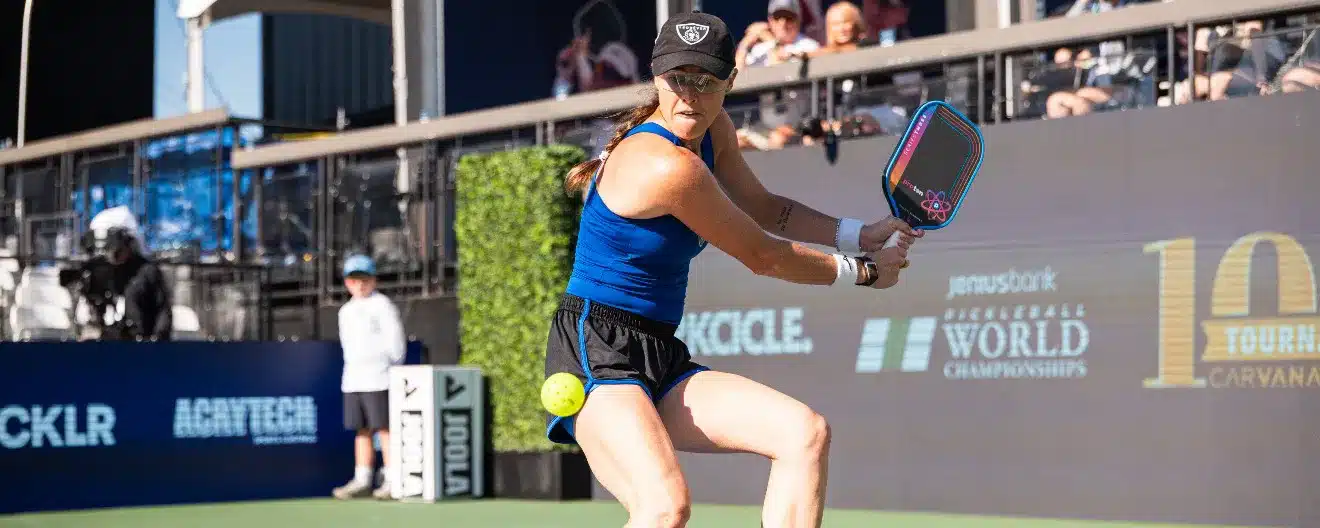Isn't it fascinating how a game as seemingly straightforward as pickleball can push the depths of scientific principles to their limits? If you're as passionate about the game as we are, you've likely had those jaw-dropping moments; watching the ball nosedive mid-air, witnessing an Erne in real-time, or even bending the ball around one of the net posts.
You're certainly not complaining when these moments occur, but you might find yourself scratching your head, wondering if you could ever recreate it... well, that's where understanding the science behind pickleball can be a real game-changer.
Let's face it - the pros aren't at the top of their sport only because of their physical fitness and dedication to practice. They reach the pinnacle of pickleball by mastering the dynamics of the game and turning physics into strategy, ultimately creating an unstoppable performance on the court. Now, for anyone who barely passed physics class in school, this most likely looks like an impossible mission. But before you close out of this post, consider the following: the most common challenge that people have with physics is understanding what it means in the real world. How does a lesson in a textbook translate into a practical application?
Once an equation becomes tangible, it's significantly easier to navigate.
By the same logic, this comprehensive guide will demystify the science of pickleball, from explaining the physics of ball trajectory to assessing the influence of paddle materials. We'll explore how grasping basic concepts can amplify your game. Ready to see pickleball under a fresh lens?
Newton's Laws of Motion and Pickleball
When you're gearing up for a pickleball game, you might not realize it, but you're also prepping for a mini physics lesson, which underscores the importance of refreshing your memory on a few of the basics. We'll start with Newton's laws of motion because they apply to every dink, drive, and serve on a pickleball court. We'll do our best to not make this as painful as 10th-grade physics class...
Newton's 1st Law | A Pickleball's Inertia
Take Newton's First Law, also known as the Law of Inertia. It says that things like to keep doing what they're doing. A ball at rest just wants to rest until your paddle comes along and gives it a nudge. Your job? Provide that nudge and set that ball in motion.
Consider this the next time you see the pickleball zipping across the net. The ball will continue on its path until it's interrupted - by your paddle, the ground, or perhaps the fence located way out of bounds. This is a given right? Let this law serve as a simple reminder to do your best to map you what the first point of contact will be in the flight path, aside from your paddle. The most difficult shot is most often the ones you decide to not take. If it's going to stay in bounds then a well-aimed shot will ideally propel the ball exactly where you want it to go - a place your opponent can't reach! Let's ramp this up a bit and look at a formula you're certainly familiar with.
Newton's 2nd Law | Power Means Speed
F=ma: Remember this little equation? That's right, force equals mass times acceleration. Newton's Second Law is all about force and acceleration, which means the harder you hit the ball, the faster it'll go. So, a gentle tap sends the ball on a leisurely journey over the net, while a full-force whack has it speeding like a bullet.
This law is particularly important in pickleball since the game is far more a showcase of finesse instead of power. That's the whole reason you don't see bangers make it very far in the sport. The rhythm of a rally truly rests in Newton's 2nd Law and your hands - a strategic blend of speed and control can keep your opponent on their toes. The big takeaway? It's not about brute strength; it's about strategically varying your force to control the ball's speed.
Newton's 3rd Law | Opposite and Equal Reaction
Newton's Third Law is probably the most famous one - for every action, there's an equal and opposite reaction. In pickleball terms, when you smack the ball with your paddle, it smacks right back, springing back into play. And the more forceful your shot, the stronger the ball's comeback.
The insight here is all about placement and strategy where the strength and angle of your shots influence the trajectory and speed of the ball's response. Mastering this law can help you accurately place your shots, whether it's a smashing winner or a crafty dink shot. Understanding this give-and-take can help you position your shots better and make your game unpredictable - need proof? Look no further than the backhand roll.
With Isaac Newton's thoughts behind us, let's talk about the ball itself.
The Aerodynamics of a Pickleball
Unlike other sports balls, a pickleball is full of tiny holes. These aren't just for show - they adjust the aerodynamics of the ball. Before you start imagining wind tunnels and flight dynamics, let's simplify it. When the pickleball soars through the air, it's battling against air resistance, or drag. Because of these holes, the ball experiences more air resistance, slowing it down and shortening its travel distance.
The ball's unique design, with its perforated, wiffle-like structure, adds an interesting twist to its flight path. These holes cause turbulence in the air around the ball, making its trajectory slightly unpredictable and the game more challenging. This means you'll need to plan your shots differently compared to other paddle and racquet sports.
The unique design of the pickleball demands a unique strategy, so think carefully about each shot, and use the ball's unique design to your advantage.
Arcs in Action: The Ball's Trajectory
At the heart of the sport, we're talking about a pickleball's trajectory - the path that the ball follows when it takes flight. Everything else has an influence but the trajectory of the ball is the star of the show. It's what ultimately results in points or no points. This trajectory isn't just random; it's shaped by many factors and forms the foundation of any skilled player's game plan. So what's behind it then?
Think about your last serve or return; the angle at which you made contact with the ball, the speed of your paddle swing, and the position of your paddle. They all play their part in charting the ball's course. Even tiny changes can massively shift the trajectory, taking a straight shot to a cleverly angled one. But let's not forget that constant hanger-on variable... gravity.
It's always tugging the ball earthwards. So it's your job to find that sweet spot to counteract gravity while getting the ball exactly where you want it to go. No pressure, right? Well, that's not the last variable in this complex formula. Throw spin into the equation and you've just introduced a shot of unpredictability. You know this in a practical sense, but reverse engineering it, the Magnus effect is the reason why.
When you spin the ball, you're essentially tinkering with the air pressure around it, causing what's known as the Magnus effect. The ball veers off its straight path, curving in the direction of the spin. Think about a topspin shot, which dives downwards sharply after crossing the net, or a backspin shot, which can make the ball hover slightly before falling. Using spin effectively can throw your opponents off-balance, making your shots harder to predict and return.
A basic understanding of a pickleball's structure, its general aerodynamics, and the importance of trajectory can often be enough to add an edge to your game. Making you a more strategic player. After all, understanding the science of your shots is just as important as having a solid forehand or a tricky serve. Now let's talk about the other main player in the gear department, our favorite topic, pickleball paddles.
Pickleball Paddles: Where Design and Physics Intersect
We may be biased, but pickleball paddles aren't just pieces of sports equipment - Paddletek's paddles in particular are carefully designed tools grounded in science, technology, and innovation. They come in a mix of materials - but the strength and lightweight nature of composites and graphites usually make them top picks. The choice of material influences the paddle's weight and how it responds when it makes contact with the ball, thus impacting the speed of your swing and the feel of the ball's hit.
The paddle's weight is integral to your game style. A heavier paddle packs a punch, giving you the power to send the ball flying with force. But on the flip side, a lighter paddle offers greater maneuverability, aiding quick reactions and finesse-filled shots. Hence, picking a paddle that harmonizes with your playing style is crucial to excelling on the court.
Now, let's talk about the paddle's size and shape, which are fundamental aspects that affect ball control. A wider paddle face offers a larger sweet spot, while a longer paddle can stretch your reach for those just-out-of-reach shots and add a bit more power and help you get over the ball. So, when you consider paddle design, it's all about harnessing the science to craft a tool that complements your unique playing style.
Each facet of a pickleball paddle has a part to play in the physics performance on the court, and there are far more components at play than the two above. If you want a guide on how to sort through them to find the right fit for you, we highly recommend reading the Paddletek paddle buyer's guide which goes through the 5 most important elements of choosing a pickleball paddle.
The Gravity of Pickleball Paddle Quality
Think of pickleball equipment like the components of an orchestra - just as a professional violinist wouldn't dream of performing with a toy violin, a pickleball player needs the right gear to truly shine. The power of a top-tier paddle can't be overstated. It's like your trusty dance partner, always ready to aid your next impressive move. A well-crafted paddle can amp up your control, spin, and power, elevating your game to the next level. Plus, a durable, responsive paddle shields you from inconsistent play, preventing the game from turning into a series of equipment glitches.
It's all about the blend of science and innovation - creating paddles that consider every player's unique needs. Every aspect of the paddle - from its weight and size to the surface texture - plays a crucial role in controlling the ball and amplifying your power. Picture this: a paddle scientifically balanced to offer the ideal mix of speed and power, turning your everyday volley into a force to be reckoned with. It's like wielding a secret weapon, ready to transform your game.
The next time you pick up your paddle, remember - it's not just a tool; it's a tribute to the science of pickleball.
Unpacking the Physics of Pickleball: Strategies for Success
Unleashing the power of physics and strategy on the pickleball court isn’t just a fun trivia exercise, it’s a game changer. If you're struggling to make the connection, let's talk about applied sciences and pickleball then.
- Court Positioning: Grasping the dynamics of how that little plastic ball zips and zags through the air can help you make educated guesses about its landing spot. The better you get at this, the more adept you become at positioning yourself for a solid return. In a game where every split second counts, this gives you a competitive advantage.
- Flight Path: Now, let's chat about the art of claiming your territory on the court. Here's where the laws of ball trajectory can be your secret weapon. By predicting the ball’s most probable flight paths, you're always one step ahead, ready and waiting in the right spot rather than scurrying after the ball. But remember, the ball can be a rebel and defy expectations, so stay nimble and ready to adapt. Use the split step to stay nimble and avoid parking in No Man's Land.
- Paddle Selection: Science also has a heavy hand in choosing the perfect paddle. Materials, core thickness, weight, surface texture, size, shape, etc. - all factor into the equation. From our short summary in the guide, remember that a weightier paddle packs a punch, but might be harder to whip around. A paddle with a bigger face gives you a broader strike zone but could be less precise. The next time you're eyeing a shiny new paddle, don't forget to pack your physics and make a choice that will truly elevate your game.
Pickleball Deconstructed: Tying up Loose Ends
A quick recap of Newton's Laws of Motion and the aerodynamics of a pickleball might not guarantee a tournament win, but they'll surely add an extra layer of strategy to your game. Again, pickleball isn't just about power and precision, but also about knowing and using the science of the sport to your advantage. By embracing this knowledge, you have the power to level up your game. Remember, knowing how a well-designed paddle enhances control or how to predict ball trajectories can give you that competitive edge. It's like you've unlocked a secret playbook, ready to be put into action on the court!
We encourage you to keep exploring the science of pickleball, staying curious and open to new insights. Every serve, volley, and smash is an opportunity to learn and grow. Continue honing your skills and you'll soon be serving up science on the court! With your newfound understanding of the science behind pickleball, it's a perfect time to experience the difference in your next game. So next time you're on the court, remember: you're not just a player, you're a physicist in the making.
Anuncie Aqui / Advertise Here
Sua marca para o mundo Pickleball! / Your brand for the Pickleball world!

 English
English  Spanish
Spanish  Portuguese
Portuguese  German
German  Italian
Italian  Japanese
Japanese  French
French  Polish
Polish  Russian
Russian  Netherlands
Netherlands  Hungarian
Hungarian  Turkish
Turkish  Videos
Videos 








 English (US) ·
English (US) ·  Portuguese (BR) ·
Portuguese (BR) ·